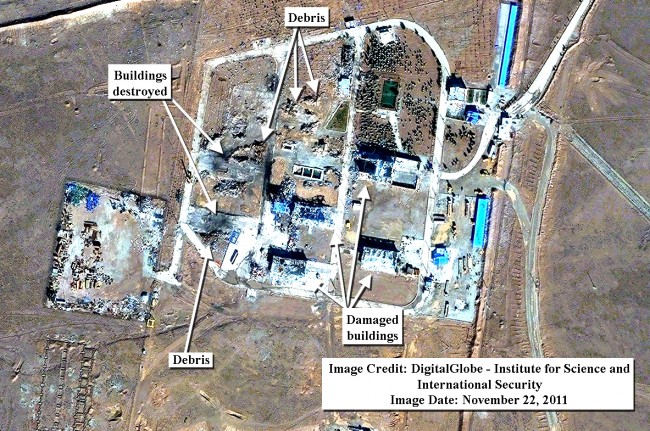Commercial satellite image of the damage at the Malard military base from the blast of 12 November 2011
At 2:40 p.m. local time Monday, an explosion shook the historic city of Isfahan, rattling residents and knocking out windows. Fars broke the story, but within an hour had withdrawn it. Officials initially said there had been a blast, then scrambled to pull back any admission --- nothing had happened; it was a military training exercise; it might have been a water boiler.
Even without the haphazard reaction of the authorities, suspicions would have centred this morning on an act of sabotage. One loud boom might be a misfortune, but two are far more than an accident. Only two weeks ago, a Revolutionary Guards base west of Tehran, one involved in missile development, had been struck by a large explosion. A satellite image which emerged yesterday (see top of entry) showed the physical destruction even if the number of killed --- officially, it is 17; indications point to a toll as high as 37 --- is uncertain.
And it is not just "two". The Islamic Republic has been beset over the last year by a series of incidents affecting oil refineries and pipelines. Someone does not want the Supreme Leader's vision of progress to take hold, in the economic or military spheres.
Whodunit in Isfahan? The stark reality is that few if any people --- beyond the perpetrators --- know this morning. Of course, the Israelis will be Suspect No. 1, possibly with the Americans as accomplices, but there are groups within Iran that would be quite happy to give the regime a punch in the eye. And it cannot be ruled out that the latest events are part of the escalating fight within the establishment.
What did they hit yesterday? That is also unclear this morning. While it was evident after the 12 November explosion that a military base had been struck, it took some time --- and then largely through the jumbled postures of information within Iran, rather than through Israeli or American proclamations --- for confirmation that a missile programme had been affected, with a senior commander killed. In Isfahan, the target is still far from evident, even though the location appears to be close both to a military academy and an air force base.
(The knee-jerk reaction of many casual observers, and some journalists who should know better, that 1) there was an explosion; 2) there is a uranium enrichment facility near Isfahan; so 3) the target was Iran's nuclear programme should be treated as fly-by-afternoon speculation. Isfahan is a very large city, rendering this instant reaction the equivalent of saying that a blast in New York must have been aimed at Wall Street.)
Yet if no target, let alone culprit, has been identified, we can still measure an effect this morning. Beyond any direct impact, the blasts are designed to spread uncertainty --- about both the attackers and the regime. Why, for example, should Israeli officials deny responsibility, even if West Jerusalem had no connection? The psychological effect on Tehran of "the bogeyman is going to get us" may already be a victory for Israel, even if the regime will try to turn that around by mobilising the public in its defence. Similarly, expect unnamed US officials to put out dark hints that their covert operations are having the desired outcome, reinforcing sanctions and making an overt military strike unnecessary.
Within Iran, the explosions do not take place in the isolation --- nukes, nukes, nukes --- often framed by media outside the country. They interact with other instability and uncertainty that is already present, from the fragile economic situation to the political in-fighting that is threatening President Ahmadinejad to --- possibly --- tensions within the military, including the Revolutionary Guards.
Nothing is settled in the Islamic Republic these days. And yesterday's incident --- be it attack, sabotage, or water boiler --- adds another loud ripple to the turbulence.
